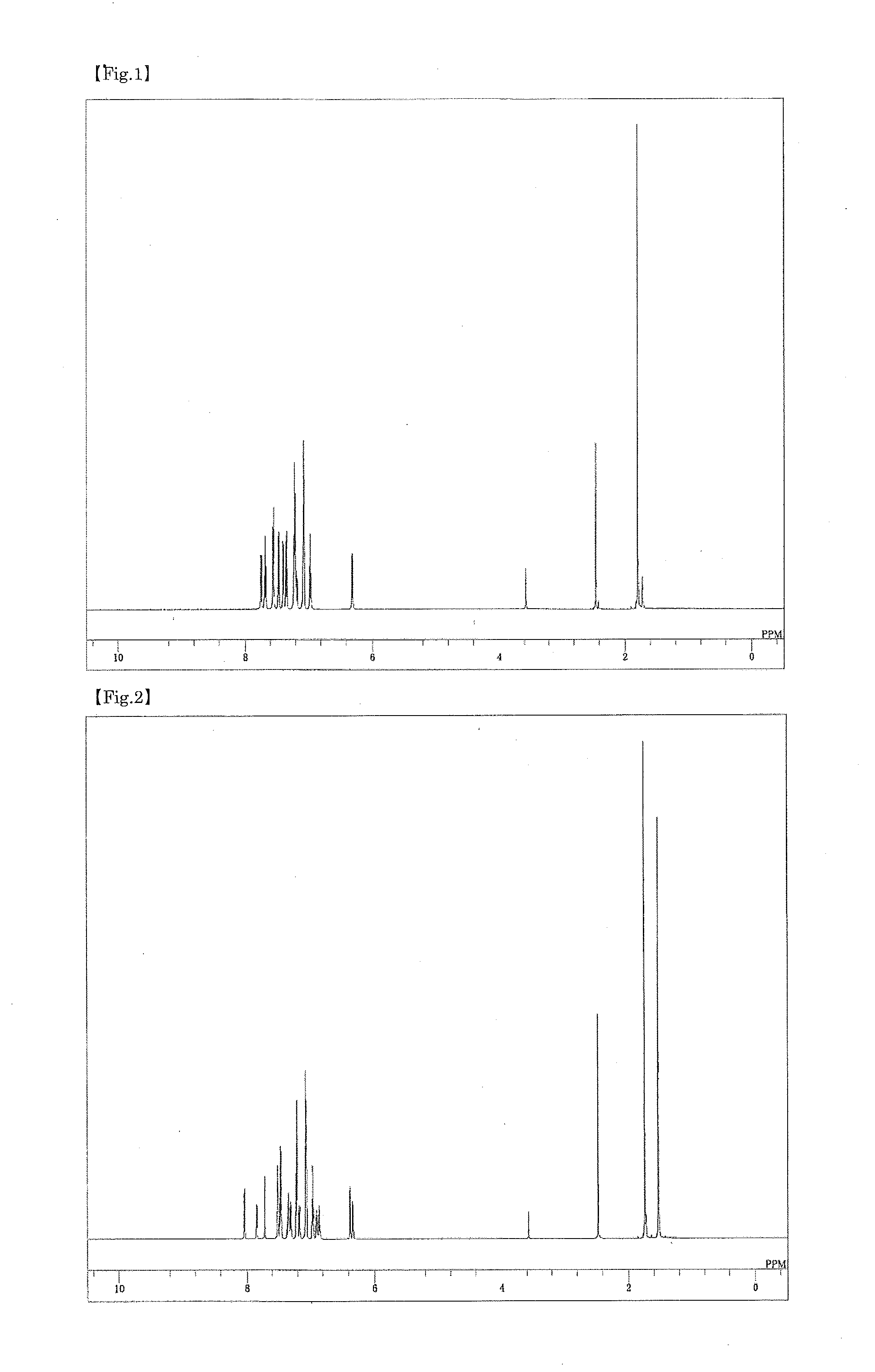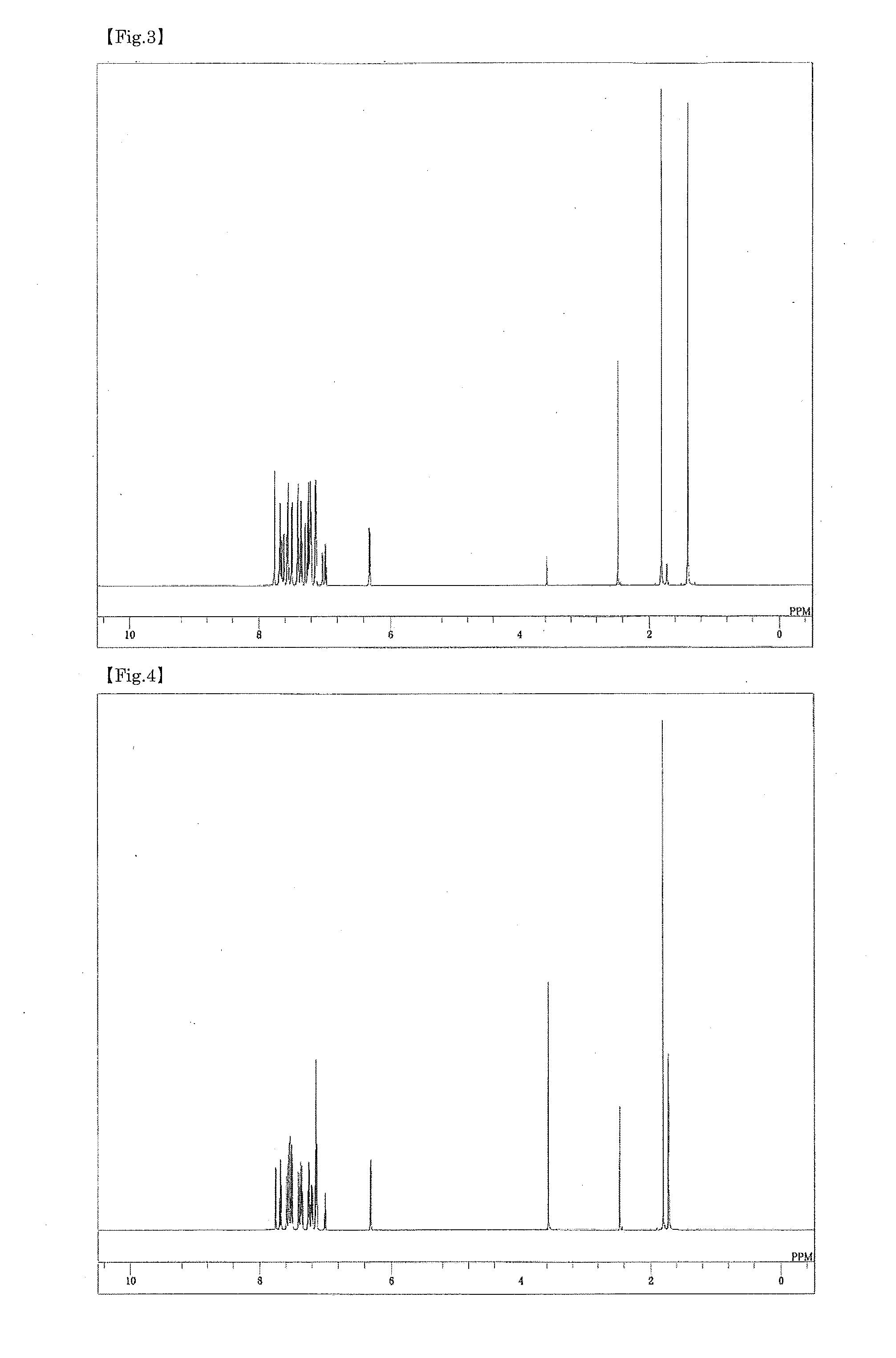Compound having acridan ring structure, and organic electroluminescent device
a technology of organic electroluminescent devices and acrid ring structures, which is applied in the preparation of amino compounds, thermoelectric devices, and rearrangement reactions. it can solve the problems of deterioration of devices, inability to achieve improvement in luminous efficiency, and material degradation, and achieve satisfactory amorphousness, excellent electron blocking ability, and excellent heat resistance
- Summary
- Abstract
- Description
- Claims
- Application Information
AI Technical Summary
Benefits of technology
Problems solved by technology
Method used
Image
Examples
example 1
Synthesis of [4-(9,9-dimethyl-7,10-diphenylacridan-2-yl)phenyl]-diphenylamine (Compound 11)
[0087]2-Bromo-9,9-dimethyl-7,10-diphenylacridan (2.54 g), 4-(diphenylamino)phenylboronic acid (1.75 g), toluene (25 ml), ethanol (2 ml), and a 2M potassium carbonate aqueous solution (9 ml) were added to a reaction vessel in a nitrogen atmosphere and aerated with nitrogen gas for 30 min under ultrasonic irradiation. The mixture was heated after adding tetrakis(triphenylphosphine)palladium (0.20 g) and stirred at 68° C. for 8 hours. The mixture was allowed to cool to a room temperature, and an organic layer was collected by a liquid separating operation. The organic layer was dried with magnesium sulfate and concentrated under reduced pressure to obtain a yellow amorphous crude product. The crude product was recrystallized with n-hexane, dissolved by adding toluene (30 ml), and purified by adsorption using silica gel (1.17 g Methanol (20 ml) was added to this solution to precipitate crystals, a...
example 2
Synthesis of {4-[10-(9,9-dimethyl-9H-fluorene-2-yl)-9,9-dimethylacridan-2-yl]phenyl}-diphenylamine (Compound 19)
[0090][4-(9,9-Dimethylacridan-2-yl)phenyl]-diphenylamine (2.02 g), 2-bromo-9,9-dimethyl-9H-fluorene (1.37 g), a copper powder (0.036 g), potassium carbonate (0.94 g), sodium bisulfite (0.078 g), and dodecane (4 ml) were added to a nitrogen-substituted reaction vessel and stirred at 200° C. for 35 hours. The mixture was allowed to cool to a room temperature, and toluene (30 ml) and methanol (30 ml) were added. Precipitated insoluble matter was removed by filtration and concentrated under reduced pressure to obtain a black crude product. The crude product was purified by column chromatography (carrier: silica gel; eluent: hexane / toluene), crystallized with diisopropyl ether / methanol, and then crystallized with ethyl acetate / diisopropyl ether / hexane to obtain a pale yellowish white powder of {4-[10-(9,9-dimethyl-9H-fluorene-2-yl)-9,9-dimethylacridan-2-yl]phenyl}-diphenylamine...
example 3
Synthesis of [4-(9,9-dimethyl-7,10-diphenylacridan-2-yl)phenyl]-(9,9-dimethyl-9H-fluorene-2-yl)-phenylamine (Compound 27)
[0093]9,9-Dimethyl-2,10-diphenyl-7-(4,4,5,5-tetramethyl-[1,3,2]dioxaboran-2-yl)acridan (2.02 g), (4-bromophenyl)-(9,9-dimethyl-9H-fluorene-2-yl)-phenylamine (1.90 g), toluene (20 ml), ethanol (2 ml), and a 2M potassium carbonate aqueous solution (6 ml) were added to a nitrogen-substituted reaction vessel and aerated with nitrogen gas for 30 min under ultrasonic irradiation. The mixture was heated after adding tetrakis(triphenylphosphine)palladium (0.14 g) and stirred at 72° C. for 8.5 hours. The mixture was allowed to cool to a room temperature, and an organic layer was collected by a liquid separating operation. The organic layer was dried with magnesium sulfate and concentrated under reduced pressure to obtain a brown crude product. The crude product was purified by column chromatography (carrier: silica gel; eluent: hexane / toluene) and crystallized with acetone...
PUM
| Property | Measurement | Unit |
|---|---|---|
| voltage | aaaaa | aaaaa |
| luminance | aaaaa | aaaaa |
| Tg | aaaaa | aaaaa |
Abstract
Description
Claims
Application Information
 Login to View More
Login to View More - R&D
- Intellectual Property
- Life Sciences
- Materials
- Tech Scout
- Unparalleled Data Quality
- Higher Quality Content
- 60% Fewer Hallucinations
Browse by: Latest US Patents, China's latest patents, Technical Efficacy Thesaurus, Application Domain, Technology Topic, Popular Technical Reports.
© 2025 PatSnap. All rights reserved.Legal|Privacy policy|Modern Slavery Act Transparency Statement|Sitemap|About US| Contact US: help@patsnap.com



